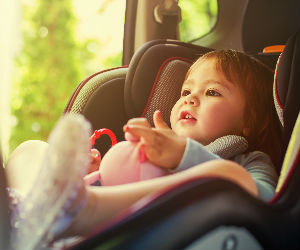
Did you know that the only baby product required by law is a car seat? That’s because car crashes are the number one cause of death and injury to children under the age of 14. And yet, most of these tragedies can be prevented. Keeping your little one safe while traveling does not have to be overwhelming.
As the Global Safety Advocate for Diono and a certified Child Passenger Safety Instructor, I get asked a lot of questions about how to keep baby safe in the car. Here are just a few tips to help get you started on car seat safety:
Start early
If you’re pregnant, select your car seat and have a certified Child Passenger Safety Technician (CPST) help you install it four to six weeks before your due date. Babies tend to have a mind of their own, arriving on their own time schedule. You don’t want to be installing the car seat at the last minute in the parking lot when you’re being discharged from the hospital.
Ask for a safety inspection
Read over the manual carefully, watch the manufacturer’s videos, and call them with any questions. If you’re lucky enough to live near a certified CPST, make an appointment and double check your installation skills. Most car seats are unknowingly installed incorrectly. It’s always a good idea to have someone else check your work.
Download our free Car Seat Buyer’s Guide.
Go snug
Be sure to snug up the baby’s harness every time he or she is in the car seat, especially if baby is in an infant-only carrier. Keeping the harness snug protects your little one while you’re carrying the car seat or if you happen to be involved in a crash.
Don’t bundle up
Though you want to keep baby warm and cozy in the cold winter months, never buckle your little one up while wearing a puffy winter jacket. Whether your child is an infant or toddler, placing them in a car seat while wearing a big, warm coat can be a safety hazard and may leave your child unprotected and unrestrained during an impact.
Be safe at the store
If you bring baby grocery shopping, place the car seat carrier into the large basket of the shopping cart where you put the groceries. Placing it on the cart handle can be dangerous and cause the cart to tip over, possibly injuring baby.
Don’t mix and match
Use only the infant cushions or pillows that come with the car seat. Manufacturers crash test with their products and know the results. They cannot verify or predict what may happen if you use another company’s product with your car seat.
Don’t feed and drive
Never nurse or feed your child while the car is moving. Even if they are screaming at the top of their lungs, never take your little one out of their car seat while the car is running. You never can anticipate when a car crash will happen. Find a safe place to pull over and turn your car off.
Take a break
If you decide to take a long trip in the car with a newborn, be sure to take baby out of the car seat at a rest stop every two hours. Check with your child’s pediatrician to be sure they are healthy enough to take long trips or fly in an airplane.
Fly with a car seat
Speaking of air travel, be sure to purchase a seat for your baby instead of carrying them on your lap. Infant-only car seats (carrier with or without a base) install easily in an airplane seat! Store the base in the overhead bin (or pack it in your luggage), and then simply install the carrier rear-facing with the lap belt. The car seat must go by the window so it doesn’t interfere with other passengers exiting the row to the aisle. Bring a small gift or a smile to the person sitting in front of it because they won’t be able to recline their seat. Better yet, book a bulkhead seat so it doesn’t interfere with anyone. Plus, it gives you more room to easily access the car seat and baby. Prior to your trip, verify with each airline their seat spacing and policies on using an infant or convertible car seat onboard.
Many parents are puzzled when I suggest using the car seat on the airplane. It’s simple physics. Laws of gravity do not change on an airplane. They only increase when you are taking off and landing at roughly 250 mph. Most injuries occur on take offs, landings and during turbulence. In addition, you and baby will be more comfortable for the duration of the flight.
Traveling with baby takes some extra planning and coordinating…and most importantly…patience! Following these Do’s and Don’ts will help keep your little one safe and make the journey a little smoother. It can be exhausting and sometimes it seems like the trip will never end but you will make it!
Safe travels.


Leave a Reply